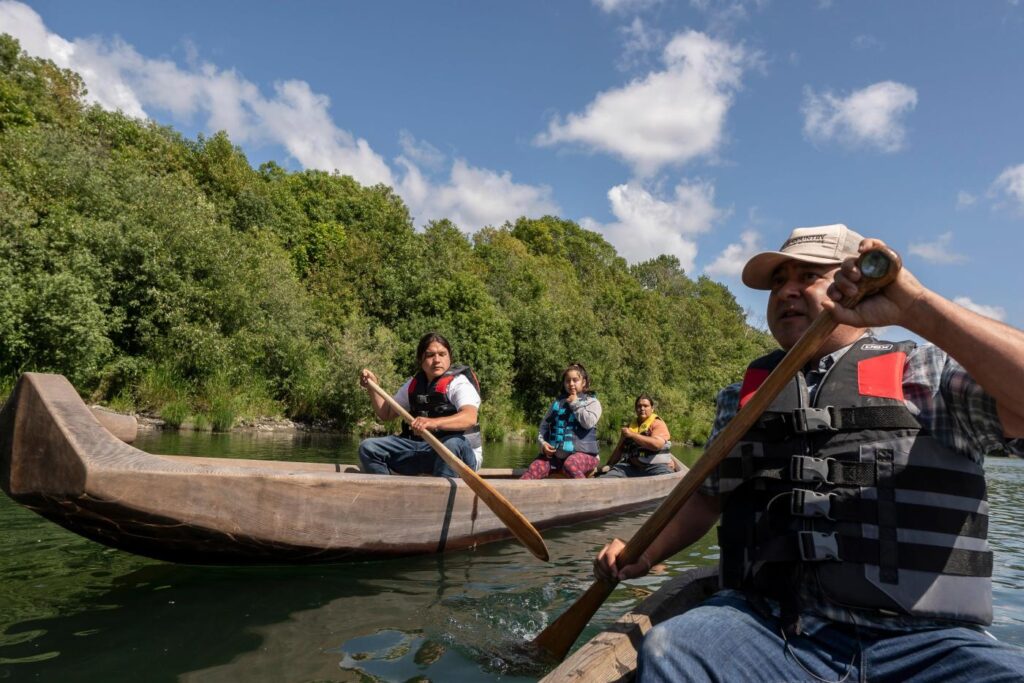
By JULIE WATSON
California’s Yurok Tribe, which had 90% of its territory taken from it during the Gold Rush of the mid-1800s, will be getting a slice of its land back to serve as a new gateway to Redwood National and State Parks visited by 1 million people a year.
The Yurok will be the first Native people to manage tribal land with the National Park Service under a historic memorandum of understanding signed Tuesday by the tribe, Redwood National and State Parks and the nonprofit Save the Redwoods League.
The agreement “starts the process of changing the narrative about how, by whom and for whom we steward natural lands,” Sam Hodder, president and CEO of Save the Redwoods League, said in a statement.
The tribe will take ownership in 2026 of 125 acres near the tiny Northern California community of Orick in Humboldt County after restoration of a local tributary, Prairie Creek, is complete under the deal. The site will introduce visitors to Yurok customs, culture and history, the tribe said.
The area is home to the world’s tallest trees — some reaching more than 350 feet. It’s about a mile from the Pacific coast and adjacent to the Redwood National and State Parks, which includes one national park and three California state parks totaling nearly 132,000 acres.
The return of the land — named ’O Rew in the Yurok Language — more than a century after it was stolen from California’s largest tribe — is proof of the “sheer will and perseverance of the Yurok people,” said Rosie Clayburn, the tribe’s cultural resources director. “We kind of don’t give up.”
For the tribe, redwoods are considered living beings and traditionally only fallen trees have been used to build their homes and canoes.
“As the original stewards of this land, we look forward to working together with the Redwood National and State Parks to manage it,” Clayburn said. “This is work that we’ve always done, and continued to fight for, but I feel like the rest of world is catching up right now and starting to see that Native people know how to manage this land the best.”
The property is at the heart of the tribe’s ancestral land and was taken in the 1800s to exploit its old-growth redwoods and other natural resources, the tribe said. Save the Redwoods League bought the property in 2013 and began working with the tribe and others to restore it.
Much of the property was paved over by a lumber operation that worked there for 50 years and also buried Prairie Creek, where salmon would swim upstream from the Pacific to spawn.
A growing Land Back movement has been returning Indigenous homelands to the descendants of those who lived there for millennia before European settlers arrived. That has seen Native American tribes taking a greater role in restoring rivers and lands to how they were before they were expropriated.
Last week, a 2.2-acre parking lot was returned to the Ohlone people where they established the first human settlement beside San Francisco Bay 5,700 years ago. In 2022, more than 500 acres of redwood forest on the Lost Coast were returned the InterTribal Sinkyone Wilderness Council, a group of 10 tribes.
The ’O Rew property represents just a tiny fraction of the more than 500,000 acres of the ancestral land of the Yurok, whose reservation straddles the lower 44 miles (70 kilometers) of the Klamath River. The Yurok tribe is also helping lead efforts in the largest dam removal project in U.S. history along the California-Oregon border to restore the Klamath and boost the salmon population.
Plans for ‘O Rew include a traditional Yurok village of redwood plank houses and a sweat house. There also will be a new visitor and cultural center displaying scores of sacred artefacts from deerskins to baskets that have been returned to the tribe from university and museum collections, Clayburn said.
The center, which will include information on the redwoods and forest restoration, also will serve as a hub for the tribe to carry out their traditions, she said.
Related Articles
Lottery fever: Mega Millions jackpot hits $893 million, while Powerball grows to $687 million
Rap legends honor hip-hop pioneer Dr. Dre as he receives star on Hollywood Walk of Fame
3 men charged with 27 felonies in high-end smash-and-grab thefts across California
Congress requests documents from UC Berkeley in widening campus antisemitism investigation
California added 154,000 jobs last year. Where were the most hires?
It will add more than a mile of new trails, including a new segment of the California Coastal Trail, with interpretive exhibits. The trails will connect to many of the existing trails inside the parks, including to popular old-growth redwood groves.
The tribe had already been restoring salmon habitat for three years on the property, building a meandering stream channel, two connected ponds and about 20 acres of floodplain while dismantling a defunct mill site. Crews also planted more than 50,000 native plants, including grass-like slough sedge, black cottonwood and coast redwood trees.
Coordinating stewardship throughout the entire watershed with the National Park Service and California State Parks is key to restoring these fish runs, the tribe said.
Salmon were once abundant in rivers and streams running through these redwood forests, But dams, logging, development and drought — due in part to climate change — have destroyed the waterways and threatened many of these species. Last year recreational and commercial king salmon fishing seasons were closed along much of the West Coast due to near-record low numbers of the iconic fish returning to their spawning grounds.
Thousands of juvenile coho and chinook salmon and steelhead have already returned to Prairie Creek along with red-legged frogs, northwestern salamanders, waterfowl and other species.
Redwoods National Park Superintendent Steve Mietz praised the restoration of the area and its return to the tribe, saying it is “healing the land while healing the relationships among all the people who inhabit this magnificent forest.”
